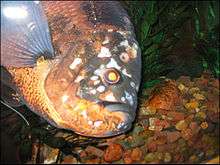Head and lateral line erosion

Head and lateral line erosion, (HLLE) or hole-in-the-head (HITH) is a disease in fish. Chronic ulcerative dermatopathy or chronic erosive dermatopathy are symptoms of similar conditions with different etiology.
Symptoms
HLLE begins as small pits of receding epithelium (skin) around the fish’s head and/or lateral line, and sometimes onto the unpaired fins. Rarely fatal, it does cause disfigurement, making the fish less suitable for public aquarium display. At least 20 families of fish have been identified as having developed HLLE in captivity. Not all species of fish show the same symptoms, and do not always develop lesions to the same degree. [1]
Causes
The most accepted cause that has the most evidence is the use of activated carbon in closed aquarium ecosystems.[2] A similar study also points to carbon as a cause of HLLE[3] Many other causes have been suggested, but have not been substantiated by any peer-reviewed studies.
Cure
[4]"Hole in the head can be reversed by removing all activated carbon and conducting large percentage water changes. Greater than 90% water changes may need to be done to reduce the effects of activated carbon. More commonly, cures are made by moving the fish to a new aquarium that has never had fish develop HLLE in it.[5]
References
- ↑ (Hemdal 2006).
- ↑ Jay Hemdal & R. Andrew Odum (2011): The Role of Activated Lignite Carbon in the Development of Head and Lateral Line Erosion in the Ocean Surgeon, North American Journal of Aquaculture, 73:4, 489-492
- ↑ Stamper MA, Kittell MM, Patel EE, Corwin AL. J Aquat Anim Health. 2011 Sep;23(3):111-6. doi: 10.1080/08997659.2011.608608. Effects of full-stream carbon filtration on the development of head and lateral line erosion syndrome (HLLES) in ocean surgeon. .
- ↑ "Mastering Freshwater Aquarium Ecosystems". Tony Griffitts (2012). aquaworldaquarium.com.
- ↑ http://microcosmaqx.typepad.com/jay_hemdal/2009/02/hlle-survey.html
